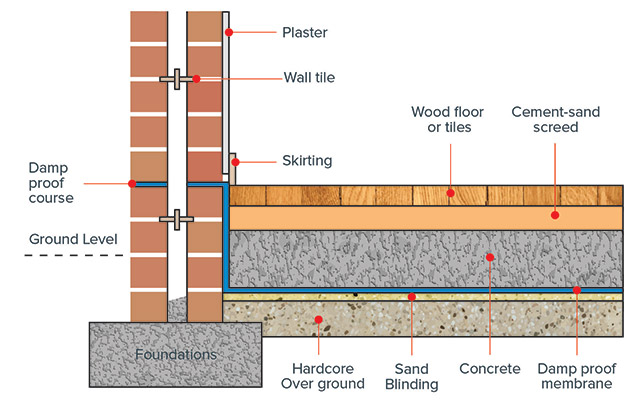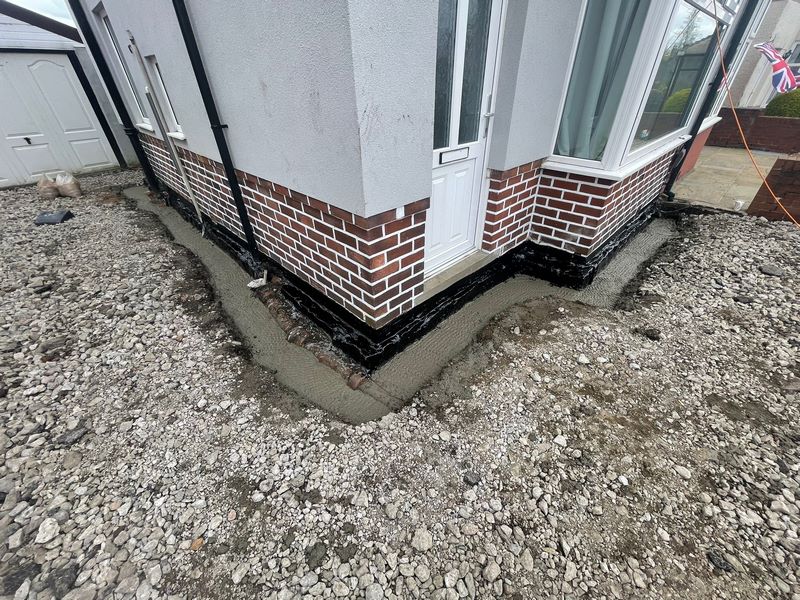Property manager's handbook to damp proofing newcastle solutions
Property manager's handbook to damp proofing newcastle solutions
Blog Article
Discovering the Numerous Methods and Solutions for Effective Damp Proofing
Moisture in structures positions considerable challenges to both architectural stability and indoor air high quality. Various methods and remedies have arised to fight this prevalent problem. From traditional damp-proof membrane layers to innovative chemical treatments, each method offers special benefits. Recognizing these alternatives is crucial for effective wetness control. Nonetheless, choosing the best option depends on specific structure problems and needs, motivating more expedition right into one of the most effective damp proofing techniques available.
Comprehending the Root Causes Of Wetness
Wetness can arise from various resources, comprehending these causes is important for effective removal. Commonly, wetness stems from three main sources: rising wet, passing through moist, and condensation. Rising wet takes place when groundwater travels upwards via porous materials, such as block or rock, usually as a result of an absence of a reliable barrier (mould removal newcastle). Permeating wet is typically triggered by exterior aspects, including roof leaks, defective gutters, or damaged wall surfaces, allowing water to penetrate a home. Condensation, on the other hand, arises from excess dampness in the air, typically worsened by bad air flow and temperature differences, causing water beads basing on surface areas. Recognizing these underlying issues is vital, as each sort of moisture calls for a customized technique for remediation. Correct evaluation assists in figuring out one of the most efficient remedies, eventually securing the structural stability of a structure and improving indoor air top quality
Conventional Damp-Proof Membrane Layers

Chemical Damp-Proofing Solutions
Chemical damp-proofing solutions provide an innovative method to stopping wetness intrusion in buildings. These methods generally entail the application of fluid chemicals that penetrate stonework and form an obstacle versus rising moist. Commonly utilized chemicals include silanes, siloxanes, and various other water-repellent representatives that respond with surface area materials to create a hydrophobic layer.The application procedure typically needs boring openings into the wall surfaces, infusing the chemical remedy, and allowing it to cure. This technique is specifically useful for older structures where traditional damp-proof membrane layers may be not practical. Additionally, chemical damp-proofing can be less turbulent and a lot more affordable than considerable improvement projects.While reliable, these services depend upon appropriate application and environmental problems for peak efficiency. Normal upkeep and surveillance are vital to ensure the longevity of the damp-proofing treatment. Overall, chemical damp-proofing represents a functional option for safeguarding buildings versus moisture-related damage
Tooth Cavity Wall Building Techniques
Tooth cavity wall surface construction techniques use countless benefits, specifically in wetness control and energy effectiveness. By integrating an air space between 2 layers of masonry, these wall surfaces successfully mitigate water access while improving insulation. This mix not just secures frameworks from dampness however likewise adds to minimized energy intake.
Advantages of Dental Caries Wall Surfaces
When considering effective moist proofing techniques, the advantages of tooth cavity walls stand out prominently. Dental caries walls include two different layers, developing an air void that properly decreases wetness penetration. This style lessens the danger of moisture, as the external wall works as an obstacle versus rainfall and water access. Furthermore, tooth cavity wall surfaces boost thermal insulation, which adds to energy efficiency by lowering heat loss. They likewise supply sound insulation, aiding to create a quieter interior atmosphere. In addition, the air void enables air flow, which assists in wetness control and lowers the chance of mold and mildew growth. These benefits not only boost the total comfort of a building yet likewise contribute to its longevity and architectural stability.
Moisture Control Strategies
Efficient moisture control strategies are crucial in cavity wall building to ensure lasting protection against dampness. One key method involves the unification of weep holes, which assist in water drainage from the dental caries, preventing accumulation. Additionally, making use of breathable membrane layers can aid take care of moisture degrees while enabling caught vapor to run away. Correct placement of insulation is likewise critical, as it should not obstruct water drainage courses. Moreover, ensuring that the outer leaves of the dental caries wall surface are created with water-resistant materials improves overall resilience. Routine upkeep checks are vital to recognize any clogs or damage early, protecting the framework's integrity. Ultimately, a mix of these strategies forms a durable defense against moisture intrusion in cavity walls.
Insulation and Energy Efficiency
Insulation plays a crucial role in improving energy effectiveness within dental caries wall surface building. By integrating protecting materials, these walls produce a thermal obstacle that decreases heat loss and reduces energy usage. Efficient insulation not just assists preserve a stable interior temperature level but additionally reduces the risk of dampness, as it avoids condensation within the wall cavity. Different methods, such as the usage of rigid foam boards or mineral woollen, can be employed to achieve ideal insulation efficiency. Furthermore, proper setup is vital to ensure that gaps and spaces are decreased, which can otherwise compromise energy efficiency. Ultimately, a well-insulated tooth cavity wall surface adds substantially to general sustainability and lowers cooling and heating expenses for house owners.
Exterior Damp Proofing Approaches
Exterior moist proofing approaches are necessary for shielding frameworks from wetness seepage. Two efficient strategies consist of the application of water-proof membranes and the installation of French drains. These solutions assist mitigate water accumulation and preserve the honesty of structures.
Waterproof Membrane Layer Application
While different approaches exist for avoiding wetness access, the application of waterproof membrane layers stays a highly reliable exterior wet proofing technique. These membranes are usually made from products such as polyethylene, rubber, or modified bitumen, providing a durable obstacle versus water penetration. The installment procedure includes using the membrane layer to the external surfaces of wall surfaces or foundations, guaranteeing total insurance coverage to prevent leaks. Correct adhesion and securing at joints are critical to making best use of efficiency. Waterproof membrane layers can be used in various types, including fluid coverings and sheet membrane layers, enabling adaptability based on the details requirements of the framework. This method not only shields structures from dampness but additionally improves their long life and architectural integrity.
French Drainpipe Installment
One efficient method for taking care of groundwater and stopping wetness build-up around a building's structure is the installation of a read more French drain. This drainage system consists of a trench loaded with gravel and a perforated pipeline that redirects surface area water far from the foundation. Appropriate installation needs mindful preparation, making certain that the drainpipe inclines far from the framework to assist in excellent water flow. Additionally, the place of the drain is crucial; it should be positioned in areas vulnerable to merging or excess moisture. Routine upkeep, including clearing up debris from the gravel and guaranteeing the pipe remains unblocked, is vital for long-lasting effectiveness. Ultimately, a well-installed French drainpipe can considerably reduce the risk of water-related issues in cellars and structures.
Interior Waterproofing Approaches
Inside waterproofing techniques are important for protecting a building's interior from dampness infiltration and possible water damages. These techniques usually include the application of specialized products and strategies developed to create a moisture obstacle within the framework. One typical strategy is using waterproof layers or sealants on walls and floorings, which stop wetness from permeating surfaces.Additionally, installing indoor drain systems, such as sump pumps, can successfully take care of water build-up in cellars and creep spaces. One more approach includes the usage of vapor barriers, which are installed to hinder dampness movement from the ground into living spaces.Moreover, addressing any type of fractures or spaces in walls or foundations with appropriate sealants guarantees a detailed defense against water breach. By implementing these indoor waterproofing techniques, residential property owners can substantially decrease the threat of mold development, structural damage, and various other moisture-related concerns. Appropriate execution of these strategies is essential for long-term security and structure honesty.
Routine Maintenance and Inspection Practices
Normal maintenance and inspection practices are crucial for guaranteeing the lasting performance of wet proofing solutions in any kind of structure. Regular checks enable homeowner to recognize very early indications of wetness breach, such as peeling paint, mold and mildew growth, and moldy smells. These indications can signify underlying concerns that require immediate attention.Inspections need to be performed at the very least annually, concentrating on at risk areas like cellars, creep rooms, and exterior walls. During these analyses, building proprietors need to analyze sealers, drainage systems, and air flow to validate they operate correctly.Additionally, maintaining gutters and downspouts is important, as stopped up systems can result in water buildup near the foundation. Implementing a normal upkeep schedule, along with prompt repair work, can considerably extend the life expectancy of wet proofing steps and shield the architectural integrity of the structure. Proactive measures ultimately add to the general wellness and security of the living environment.
Regularly Asked Inquiries
Just How Long Does Damp Proofing Generally Last?
The duration of wet proofing performance varies, typically lasting in between 20 to half a century. Aspects such as application quality, ecological problems, and maintenance methods substantially affect the long life of the wet proofing treatment.

Can I Damp Proof My Home Myself?
The private pondered the feasibility of do it yourself damp proofing. With appropriate study and the right products, it is possible. Nonetheless, they likewise acknowledged the value of expert support to assure resilient effectiveness and avoid future issues.
What Are the Indicators of Ineffective Damp Proofing?
Indications of inefficient moist proofing include consistent mildewy smells, noticeable mold and mildew growth, peeling off paint, wet spots on wall surfaces, and timber decay - damp removal newcastle. Property owners must attend to these issues immediately to avoid additional damage and health and wellness worries
Does Damp Proofing Affect Indoor Air Quality?

How Much Does Professional Damp Proofing Expense?
Specialist damp proofing costs differ substantially, typically varying from $1,000 to $5,000 relying on the home's size, the degree of the moist concern, and chosen techniques. Each scenario calls for a tailored assessment for accurate rates. Frequently, dampness stems from three main resources: rising moist, penetrating moist, and condensation. When considering reliable moist proofing approaches, the benefits of dental caries walls stand out plainly. Exterior damp proofing approaches are necessary for safeguarding frameworks from wetness seepage. While different methods exist for protecting against wetness access, the application of waterproof membrane layers continues to be a very reliable external damp proofing strategy. Indicators of inadequate moist proofing include persistent stuffy odors, noticeable mold and mildew growth, peeling paint, damp spots on walls, and wood decay.
Report this page